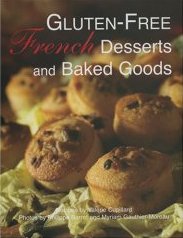The Gluten-Free Label: What it Means, What it Doesn't & What Everyone With Gluten Sensitivity Needs to Know
by www.SixWise.com
Gluten is a protein found in many types of grains, and the
foods made out of them. All types of wheat (including farina,
graham flour, semolina and durum), barley, rye, bulgur, Kamut,
kasha, matzo meal, spelt and triticale contain gluten, as
do foods such as bread, pizza dough, cookies, pasta, crackers,
gravies, sauces, cakes and many more. Oats may also contain
gluten.
|

For those with celiac disease or gluten intolerance,
finding gluten-free products in the grocery store can
be a challenge -- particularly because the gluten-free
label is still being defined.
|
For some, particularly those with celiac
disease or gluten sensitivities, eating gluten causes
an immune reaction that damages the surface of the small intestine.
As a result, their ability to absorb nutrients from food decreases,
which can lead to severe vitamin deficiencies, malnourishment
and illness.
Though there is no cure for celiac disease, it can be managed
by avoiding dietary gluten. As such, a number of food products
have come out in gluten-free or low-gluten varieties to cater
to this population.
Gluten-Free Foods May Still Contain Gluten
While a gluten-free label can make life much easier for those
with celiac disease or gluten intolerance (as it is difficult
to find many foods without gluten), there is currently no
U.S. Food and Drug Administration (FDA) regulation that defines
the term "gluten-free."
However, the FDA has allowed the "gluten-free"
label to be used anyway, provided it is "truthful and
not misleading."
Nonetheless, some foods with a gluten-free label will still
contain gluten. This is because many of these foods contain
a special starch that has been treated to remove the amount
of gluten, but it is impossible to remove it all, according
to the UK's Food Standards Agency.
How Much Gluten is Allowed in Gluten-Free Foods?
|

On a gluten-free diet? Gluten-Free
French Desserts And Baked Goods has over 100 irresistible
recipes for breads, tarts, cakes, puddings, custards,
crêpes, cookies, brownies, and bars -- all made
with gluten-free ingredients!
|
To date, there is no legal definition of "gluten-free,"
but there is an international standard for gluten-free products
called Codex Alimentarius. The standard allows products to
be labeled as gluten-free if there are less than 200 parts
per million (ppm) of gluten in the final product, according
to the Food Standards Agency.
In the United States, the FDA has proposed a regulation to
further limit the amount of gluten allowed in foods with the
gluten-free label. If the regulation is passed, gluten-free
foods would contain less than 20 ppm of gluten. A final regulation
must be issued by the FDA by August 2008. This standard of
less than 20 ppm is also being proposed internationally.
Meanwhile, the Gluten-Free Certification Organization, an
independent organization that's part of the Gluten Intolerance
Group, has their own Certified Gluten-Free label, which has
a standard of less than 10 ppm of gluten.
How Much Gluten is Safe?
A study published in the American Journal of Clinical Nutrition
by researchers from the University of Maryland Center for
Celiac Research found that in order to "treat" celiac
disease people with the condition should ingest under 50 mg/day
of gluten.
However, another study by the Center in conjunction with
the University of Ancona in Italy (which is expected to be
published in the American Journal of Clinical Nutrition),
aimed at establishing the maximum amount of gluten that could
be tolerated by people with celiac disease. They found that
10 mg/day of gluten was safe.
An Ideal Resource for Those Looking to Avoid Gluten
If you are trying to avoid gluten in your diet, it can be
challenging to find alternative sources of flour and recipes
that actually taste good ... especially for dessert-oriented
ones.
A highly recommended resource is Gluten-Free
French Desserts And Baked Goods, which provides recipes
-- over 100 in all -- for a dazzling array of quick breads,
tarts, cakes, puddings, custards, crêpes, cookies, brownies,
and bars -- all imaginatively reformulated for gluten-free
diets. (Even those who don't have to eat gluten-free will
love this book!)
Of course, those following a gluten-free diet can always
feel safe eating the following naturally gluten-free foods:
-
Fresh meats, fish and poultry (without breading or marinades)
-
Most dairy products
-
Fruits
-
Vegetables
-
Rice
-
Potatoes
-
Gluten-free flours (rice, soy, corn, tapioca, potato)
Recommended Reading
Got
Abdominal Pain, Diarrhea or Other Digestive Issues? It May
Be Celiac Disease
The
Top 8 Foods People Are Most Sensitive To -- Without Even Knowing
It!
Sources
American
Journal of Clinical Nutrition, 2007 Jan;85(1):160-6
The
University of Maryland Center for Celiac Research
U.S.
FDA Center for Food Safety and Applied Nutrition
Gluten-Free
Certification Organization
Food
Standards Agency